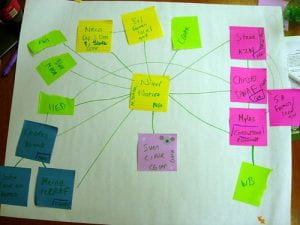
A knowledge of networking and networks is becoming increasingly important in our society and for education.
But what is a network? A network is a group of people joined together – today mostly by digital means (Oddone, 2017). Oddone also outlines four defining features of networks. They are:
- ‘Nodes – points on the network
- Relations – the lines in the network, connecting in one specific interaction
- Ties – also connectors, but reflecting the totality of relations between nodes
- The network itself – how the nodes, relations and ties combine to interact as networks’.
You can read more on Oddone’s post here.
As technology becomes more readily available and information increases it is important that we know how to use networks to find information. Before beginning this course I had an understanding of networks in the traditional sense but no formal understanding of how they worked with technology. McClure (1994) and Rhinegold (2011) present two views on network literacy but they both believe it is imperative for people to understand networks and how they work in order to make the most of opportunities in their personal and professional lives. McLure defined network literacy as a set of knowledge and skills needed to have the ability to identify, access and use information from an electronic network.
Rhinegold explains that the way the internet coding protocols (ICP) were established at the creation of the net changed the way data could be sent. There is now no centralised control, although government, laws and markets influence the structure. This lack of centralised structure makes the internet available to anybody who knows ICP – it is the ‘end-to-end’ principle. Whereas McLure’s views were on information retrieval from the network Rhinegold uses many theories, including Reed’s Law to demonstrate how networks now function with the advancement of technology and the introduction of web 2.0. Now networks are based around groups and these groups interact with each other to share information and knowledge regardless of time or distance barriers.
As I progress through my learning, it becomes increasingly clear how important networks are to learning about new resources, practises and opportunities.
Network learning is also becoming increasingly important in our education systems. Network learning is ICT used to promote connections for learning. Schools are seeing an increased need to use ICT skills for teaching and learning, however, the way in which ICT is used in learning and assessments is different to how they would be used in the workplace. A lot of student’s skills are assessed in isolation without being able to use ICT knowledge and skills as they would in the workplace. Student’s are also often tested individually, rather than a mix of both individual and collaborative work as they would be expected to achieve in the workplace (Wilson, Scalise & Gochyyev, 2015).
The lack of integration between the way employers expect employees to utilise technology and collaborative skills and the way the education system teaches and assesses these skills leaves a widening gap. This leads to the question – are students taught to integrate ICT and networks into their lives in a way that will be beneficial to their future? Does the education system need to change the way it implements and assesses? How does a teacher achieve this in an institution steeped in traditional systems?
References:
McClure, C. R. (1994). Network literacy: A role for libraries? Information Technology and Libraries, 13(2), 115-125. Retrieved from Proquest Ebook Central.
Oddone, K. (2016, September 5). Networks, networking and network literacy – Part 1 [Blogpost]. Retrieved from https://www.linkinglearning.com.au/what-is-network-literacy-and-is-it-important/
Rheingold, H. (2011, February 13). Network literacy part 1 [online video]. Retrieved from https://youtu.be/g6UKWozzVRM
Rheingold, H. (2011, February 13). Network literacy part 2 [online video]. Retrieved from https://youtu.be/g6UKWozzVRM
Wilson, M., Scalise, K., & Gochyyev, P. (2015). Rethinking ICT literacy: From computer skills to social network settings. Thinking Skills and Creativity, 18, 65-80.
